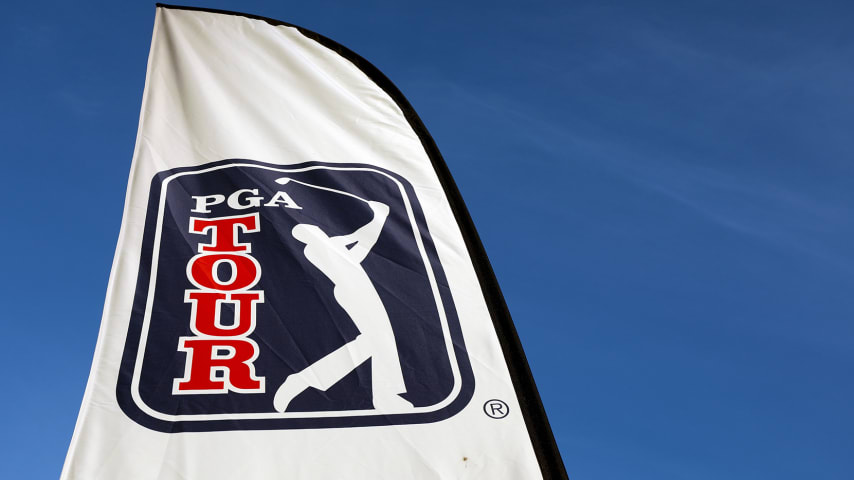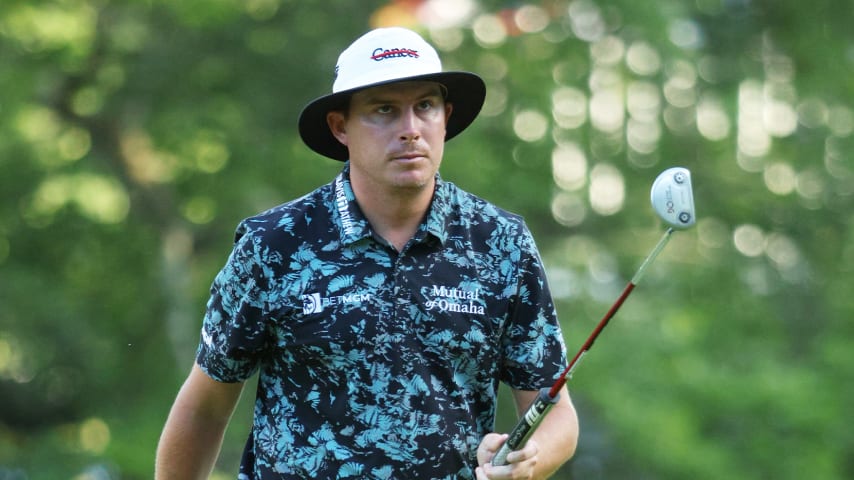Payne Stewart’s final act: His legacy lives on through an act of sportsmanship at The Country Club
8 Min Read

The 1999 Ryder Cup concluded with his act of sportsmanship
Escrito por Kevin Robbins
The 1999 Ryder Cup concluded with his act of sportsmanship
As they arrive for the 122nd U.S. Open, players entering the august locker room at The Country Club will pass a shirt framed in wood, hanging on a paneled wall, folded as neatly as origami. Many contestants — maybe all 156 — will recognize the familiar pattern on the crimson garment. It might be the most famous collage in the history of golf.
The shirt belonged to Payne Stewart. He wore it on Singles Sunday at the 1999 Ryder Cup. He took the last shot on that sunny afternoon of Sept. 26 in Brookline, Massachusetts, right outside Boston: a splash from a greenside bunker on the 18th hole. Moments later, Stewart conceded his match to Colin Montgomerie of Scotland, a gesture of selflessness and sportsmanship often forgotten, given the circumstances. A month later, he was dead.
Stewart and five others perished the morning of Oct. 25 aboard a Learjet on its way from Orlando to Dallas. He was 42 years old. He was the reigning U.S. Open champion, the holder of 10 other titles on the PGA TOUR and seven others in Asia, Africa, Australia and Europe. He was, in many ways, a changed man. A resplendent 1999 season reflected a personal evolution that touched many, players and fans alike. The striking figure in plus-fours and a flat cap —brash and cocksure in his younger days — had emerged from a years-long slump as a more measured and mature individual. Remember the tender way he held Phil Mickelson’s face in his hands after he beat him in the 1999 U.S. Open at Pinehurst? That was the Payne Stewart we lost. That was the man who gave Montgomerie a Ryder Cup match in the shirt the players will see when the national championship returns to The Country Club, one of the six founding clubs of the USGA.
Fred Waterman, the historian of the club, procured the shirt from Tracey Stewart, Payne’s wife. She agreed to loan it to the club through June. “The U.S. Open is coming to the Country Club because of our history,” Waterman said. “Stewart was very much a part of that history. Having his shirt there would be meaningful to the players who knew him — and those who wished that they had.”
Stewart was one of 12 players on that Ryder Cup team captained by Ben Crenshaw. The U.S. was down 10-6 after the first two days of matches. Stewart hadn’t played all that well in Foursomes and Four-balls. But he was a leader on the team, one of the elders on a squad that included a young Tiger Woods, David Duval, Mickelson and Justin Leonard, whose long and unlikely putt all but completed a comeback for all of time.
The United States was trailing, 10-6, at the start of the day. No team had ever come back from such a large deficit entering the final day. Which is exactly why Crenshaw put Stewart in the 10th singles match.
The captain knew he could count on a veteran of five Ryder Cup teams if it came down to the end.
From the beginning of the contentious match between the reigning U.S. Open champ and Europe’s top player, abuse rained from the rowdy spectators at The Country Club. “Shank it, you fat pig!” someone yelled as Montgomerie settled over a shot early in the round. More taunts and insults followed from the partisan crowd. Montgomerie ignored the petty name-calling and settled into a deliberate pace, rankling the impatient hecklers. Stewart hit a lovely approach at the third, earning a concession. Montgomerie buried a long putt to halve the hole. The satisfaction that registered on the Scotsman’s face widened the target on his broad back. He slowed his pace more.
“Get on with it!” someone shouted during his pre-shot routine at No. 6. “I’ve got tickets to the Patriots tonight!”
Montgomerie got on with it. He went 3 up through seven. Stewart took the eighth and ninth. Between the ninth green and the 10th tee, someone threw a beer, spraying Montgomerie’s wife with foam. Stewart had seen and heard enough.
“I’m sorry,” he told Montgomerie, and then pointed out the offender. Security ejected the culprit.
The defense of Montgomerie struck some as odd, especially in the heat of a Ryder Cup comeback. A younger, brasher Stewart might not have objected to the verbal assault. He might’ve seen humor in it, even encouraged it, and certainly would’ve considered it a competitive edge. But the Stewart in the last match at the ’99 Ryder Cup was the man who leaned in and told Montgomerie over the din: “Look, if there are any more problems, let me know. I’ll let the referees know. We’ll deal with it.” This was the Stewart who found himself in the left rough of the 17th hole, a short-iron shot from the hole, with Montgomerie in the fairway, the two of them tangled in a tied match with the Ryder Cup still in the balance, when Justin Leonard locked into his stance over a long putt on the green ahead and took one last look at his line.
Stewart and Montgomerie squinted to watch.
They didn’t see Leonard’s putt fall. But they heard it. The property shook in an explosion of sound and color and the entire range of human emotion. The ensuing mayhem on the 17th green rattled Olazábal to the extent that he effectively had no chance to hole his own putt to halve the hole. The U.S. team clinched the Cup before Stewart and Montgomerie could do anything about it.
The 11th and 12th matches behind them also had been settled. They were now the last match on the course.
They halved the 17th. Few noticed. Montgomerie slumped and marched ahead with no evident conviction, a player with no purpose, a shell of a man with a driver in his hand. They made their way through the claustrophobic mass of humanity and teed their balls at the 18th as the last match on the course in a competition that had already been decided.
Both drove well. Stewart’s approach missed the green and finished in a bunker. On a personal level, he wanted the point as surely as Montgomerie did. Stewart’s career Ryder Cup record mattered to his prospects as a future captain, as it did to his pride. But he also began to reflect on the appeal of a concession, of giving Montgomerie his putt, of the grace he wanted to show his fellow-competitor. A tie would save Montgomerie from even more belligerence and abuse, Stewart thought.
Montgomerie had been through a lot, after all. Stewart looked up for a moment and scanned his surroundings: the primrose-yellow clapboard clubhouse, the old elms, the frothy gallery waiting to explode. So many American flags. So many fists in the air. He saw Mickelson with his arm around his wife, Amy. He sighted Tom Lehman, Mark O’Meara, and Hal Sutton huddled with his teammates. He pictured Paul Azinger, his best friend on the TOUR, and imagined the smile on his face, wherever he was watching. What a moment, Stewart thought. What a year. What a year it will be next season, and the season after that.
And then he made his choice.
Montgomerie had marked his ball on the green. He could see the crowd swelling, but not his sullen teammates. He could hear the slapping of backs, the chanting of drunkards, the whoops, and the howls. He leaned on his putter and waited for Stewart’s splash from the bunker. Montgomerie gave a quick, half-hearted look at the line on his medium-length birdie putt that might mean a point or a halve to a losing cause. He tried to summon enough pride of his own to make it matter.
Then he saw Stewart walk over and pick up his coin.
It was over. Stewart accepted the loss; he even embraced it. Montgomerie bowed his head, rose, and applauded his opponent. They shook hands.
“That’s enough for today, don’t you think?” Stewart said.
“I’d have to agree,” Montgomerie replied.
A few steps away, Bill Rogers, the U.S. vice-captain, sat in his cart and absorbed the celebration. He considered the unexpected beauty of the gesture he had just seen.
“Stewart,” Rogers thought. “The man for the moment.”
The man for the moment made one more start on the TOUR. He missed the cut at Walt Disney World. Then he boarded a Learjet at Orlando International Airport. He was due to arrive in Dallas for lunch, then proceed to Houston, where he was in the field for the TOUR Championship. Then, moments into the ascent, something went wrong.
The cabin depressurized, starving those aboard of oxygen. The four passengers and two pilots died long before the Learjet, flying on autopilot, ran out of fuel four hours later and plummeted into a South Dakota prairie. By that night, Stewart’s parking space at Champions Golf Club had become a memorial ground, full of flowers and notes and poems written by hand.
The TOUR created the Payne Stewart Award presented by Southern Company a year after his death. The award recognizes charity, character and sportsmanship. Arnold Palmer was its first recipient. Justin Rose won it in 2021.
Rose will be in the field for the 122nd U.S. Open at The Country Club. He wasn’t on that 1999 Ryder Cup team, but he’ll surely recognize the Stewart shirt when he sees it. He likely knows the story of why it’s there on the wall. And if he wants to see the last shot of those historic matches at Brookline, he need only to look around. There, in the bar inside the men’s locker room, a framed color photograph hangs on a wall. It’s of Stewart, in full follow-through, hands high, his feet buried in the bunker at the 18th green. It was a shot that seemed not to matter at the time.
But it does now. It always will.





